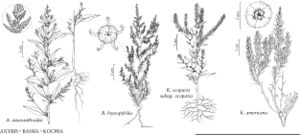Difference between revisions of "Kochia scoparia subsp. scoparia"
FNA>Volume Importer |
FNA>Volume Importer |
(No difference)
| |
Revision as of 22:24, 16 December 2019
Plants green or yellowish green, often becoming reddish at maturity, 25–150(–200) cm, ± glabrous or slightly pubescent. Stems erect, branched. Leaves sessile (proximal sometimes with pseudopetiole); blade (1–)3–5-veined, narrowly obovate, lanceolate, or almost linear, flat, 5–75 × 1–15 mm, not fleshy, margins long-ciliate, glabrous or with short appressed hairs adaxially. Inflorescences generally sparsely spicate at maturity; with 1–2(–5)-flowers in axils of bracts. Perianth segments glabrous or nearly so; bisexual flowers transversely winged or keeled (rarely tubercled) at maturity, wing membranous, to 1–1.3 mm; pistillate flowers generally wingless. 2n = 18.
Phenology: Flowering late summer–fall.
Habitat: Waste places, cultivated fields, roadsides, other disturbed habitats, seminatural plant communities in arid regions, some forms occasionally cultivated
Elevation: 0-2000 m
Distribution
Alta., B.C., Man., N.B., Ont., Que., Sask., Ala., Ariz., Calif., Colo., Conn., Del., Idaho, Ill., Ind., Iowa, Kans., Ky., La., Md., Mass., Mich., Minn., Miss., Mo., Mont., Nebr., Nev., N.H., N.Mex., N.Y., N.C., N.Dak., Ohio, Okla., Oreg., Pa., R.I., S.C., S.Dak., Tenn., Tex., Utah, Vt., Va., Wash., Wis., Wyo., nearly worldwide, native to arid steppe and desert regions of Eurasia.
Discussion
Kochia scoparia is a common weed, especially in the Southwest and the Great Plains region. It is less common in the eastern (especially southeastern) United States, although its distribution there is in need of clarification. It can be expected in Arkansas, District of Columbia, Florida, Georgia, and West Virginia although no reports are known from those states.
Kochia scoparia is extremely variable. It is represented in Eurasia by several geographical races usually recognized as subspecies (subsp. scoparia, native to eastern Europe and southwestern Asia; subsp. densiflora (Turczaninov ex Moquin-Tandon) Aellen, native to central and eastern Asia; subsp. indica (Wight) Aellen, native to southern Asia); and subsp. hirsutissima Sukhorukov recently described from Central Asia) or varieties. Kochia scoparia var. subvillosa Moquin-Tandon (= K. scoparia subsp. densiflora; K. sieversiana auct. pro parte, non (Pallas) C. A. Meyer) sometimes occurs in North America as a casual alien. In its typical form var. subvillosa Moquin-Tandon may be distinguished from var. scoparia in having flowers surrounded by a tuft of long hairs exceeding the perianth segments, the axis of the inflorescence distinctly pubescent, and the proximal branches arcuate, almost ascending. Kochia indica Wight is probably a distinct species, which may be expected as a casual or locally naturalized alien in the southern part of the United States.
A narrow-leaved form [Kochia scoparia forma trichophylla (A. Voss) Stapf ex Schinz & Thellung] known as “summer-cypress” is widely cultivated as an ornamental plant and sometimes escapes.
An Asian species, Kochia iranica Bornmueller has been erroneously reported for Colorado and Missouri by W. A. Weber (1966, 1972) and V. Muhlenbach (1979) respectively (the pertinent herbarium specimens belong to subsp. scoparia).
Kochia alata Bates, described as a presumably native North American species, is not specifically distinct from K. scoparia sensu lato, especially from its eastern Asian forms characterized by the somewhat greater wings of the fruiting perianth.
Another annual species, Kochia laniflora (S. G. Gmelin) Borbás, is widely distributed in Eurasia and may be expected anywhere in temperate North America as a casual or established alien. This species belongs to sect. Kochia and can be readily distinguished from K. scoparia sensu lato in having narrowly linear or filiform leaves and more prominently winged perianth segments.
Selected References
None.
